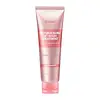What's inside
What's inside
 Key Ingredients
Key Ingredients

No key ingredients
 Benefits
Benefits

 Concerns
Concerns

 Ingredients Side-by-side
Ingredients Side-by-side

Cyclopentasiloxane
EmollientWater
Skin ConditioningButylene Glycol
HumectantDimethiconol
EmollientCetyl Alcohol
EmollientGlycerin
HumectantBehentrimonium Chloride
PreservativeStearyl Alcohol
EmollientCetrimonium Chloride
AntimicrobialIsopropyl Alcohol
SolventMyristyl Alcohol
EmollientRosa Centifolia Flower Extract
AstringentCaprylyl Glycol
EmollientLauryl Alcohol
Emollient1,2-Hexanediol
Skin ConditioningMaltodextrin
AbsorbentHibiscus Sabdariffa Flower Extract
Skin ConditioningTulipa Gesneriana Flower Extract
Skin ConditioningChlorella Ferment
Skin ConditioningPrunus Amygdalus Dulcis Oil
Skin ConditioningPistacia Vera Seed Oil
Skin ConditioningGardenia Taitensis Flower Extract
Skin ConditioningAleurites Moluccanus Seed Oil
Skin ConditioningMacadamia Ternifolia Seed Oil
EmollientSclerocarya Birrea Seed Oil
HumectantPropanediol
SolventPolysorbate 20
EmulsifyingCitric Acid
BufferingSodium Citrate
BufferingHydrolyzed Soy Protein
HumectantHydrolyzed Corn Protein
Skin ConditioningHydrolyzed Wheat Protein
Skin ConditioningGlycine
BufferingSerine
MaskingGlutamic Acid
HumectantBenzyl Glycol
SolventAspartic Acid
MaskingLeucine
Skin ConditioningHydrolyzed Glycosaminoglycans
HumectantSodium Hyaluronate
HumectantAlanine
MaskingLysine
Skin ConditioningArginine
MaskingTyrosine
MaskingPhenylalanine
MaskingProline
Skin ConditioningThreonine
Valine
MaskingIsoleucine
Skin ConditioningEthylhexylglycerin
Skin ConditioningHistidine
HumectantCysteine
AntioxidantMethionine
Skin ConditioningSodium Hyaluronate Crosspolymer
HumectantHydrolyzed Hyaluronic Acid
HumectantHydroxypropyltrimonium Hyaluronate
Hyaluronic Acid
HumectantSodium Acetylated Hyaluronate
HumectantDisodium EDTA
Hydroxyacetophenone
AntioxidantChlorphenesin
AntimicrobialParfum
MaskingCyclopentasiloxane, Water, Butylene Glycol, Dimethiconol, Cetyl Alcohol, Glycerin, Behentrimonium Chloride, Stearyl Alcohol, Cetrimonium Chloride, Isopropyl Alcohol, Myristyl Alcohol, Rosa Centifolia Flower Extract, Caprylyl Glycol, Lauryl Alcohol, 1,2-Hexanediol, Maltodextrin, Hibiscus Sabdariffa Flower Extract, Tulipa Gesneriana Flower Extract, Chlorella Ferment, Prunus Amygdalus Dulcis Oil, Pistacia Vera Seed Oil, Gardenia Taitensis Flower Extract, Aleurites Moluccanus Seed Oil, Macadamia Ternifolia Seed Oil, Sclerocarya Birrea Seed Oil, Propanediol, Polysorbate 20, Citric Acid, Sodium Citrate, Hydrolyzed Soy Protein, Hydrolyzed Corn Protein, Hydrolyzed Wheat Protein, Glycine, Serine, Glutamic Acid, Benzyl Glycol, Aspartic Acid, Leucine, Hydrolyzed Glycosaminoglycans, Sodium Hyaluronate, Alanine, Lysine, Arginine, Tyrosine, Phenylalanine, Proline, Threonine, Valine, Isoleucine, Ethylhexylglycerin, Histidine, Cysteine, Methionine, Sodium Hyaluronate Crosspolymer, Hydrolyzed Hyaluronic Acid, Hydroxypropyltrimonium Hyaluronate, Hyaluronic Acid, Sodium Acetylated Hyaluronate, Disodium EDTA, Hydroxyacetophenone, Chlorphenesin, Parfum
Water
Skin ConditioningCetyl Alcohol
EmollientStearyl Alcohol
EmollientDimethicone
EmollientPolysorbate 20
EmulsifyingCetrimonium Chloride
AntimicrobialGlyceryl Stearate Se
EmulsifyingPropylene Glycol
HumectantHelianthus Annuus Seed Oil
EmollientSilk Amino Acids
HumectantRosmarinus Officinalis Extract
AntimicrobialPanthenol
Skin ConditioningMica
Cosmetic ColorantPhenoxyethanol
PreservativeMethylparaben
PreservativeEthylparaben
PreservativePropylparaben
PreservativeParfum
MaskingIngredients Explained
These ingredients are found in both products.
Ingredients higher up in an ingredient list are typically present in a larger amount.
This ingredient is a preservative, antimicrobial, and emulsifier. It is often used in cosmetics for its ability to cleanse, condition, and reduce static.
Cetrimonium chloride is a quaternary ammonium salt, meaning it has a water-soluble structure.
Cetyl Alcohol is a fatty alcohol. Fatty Alcohols are most often used as an emollient or to thicken a product.
Its main roles are:
Though it has "alcohol" in the name, it is not related to denatured alcohol or ethyl alcohol.
The FDA allows products labeled "alcohol-free" to have fatty alcohols.
Learn more about Cetyl AlcoholParfum is a catch-all term for an ingredient or more that is used to give a scent to products.
Also called "fragrance", this ingredient can be a blend of hundreds of chemicals or plant oils. This means every product with "fragrance" or "parfum" in the ingredients list is a different mixture.
For instance, Habanolide is a proprietary trade name for a specific aroma chemical. When used as a fragrance ingredient in cosmetics, most aroma chemicals fall under the broad labeling category of “FRAGRANCE” or “PARFUM” according to EU and US regulations.
The term 'parfum' or 'fragrance' is not regulated in many countries. In many cases, it is up to the brand to define this term.
For instance, many brands choose to label themselves as "fragrance-free" because they are not using synthetic fragrances. However, their products may still contain ingredients such as essential oils that are considered a fragrance by INCI standards.
One example is Calendula flower extract. Calendula is an essential oil that still imparts a scent or 'fragrance'.
Depending on the blend, the ingredients in the mixture can cause allergies and sensitivities on the skin. Some ingredients that are known EU allergens include linalool and citronellol.
Parfum can also be used to mask or cover an unpleasant scent.
The bottom line is: not all fragrances/parfum/ingredients are created equally. If you are worried about fragrances, we recommend taking a closer look at an ingredient. And of course, we always recommend speaking with a professional.
Learn more about ParfumPolysorbate 20 is made by combining ethoxylation of sorbitan, ethylene oxide, and lauric acid. It is a mild cleansing agent, surfactant, and emulsifier.
As a surfactant, it helps collect dirt and oils for washing. Emulsifiers prevent oils and water from separating.
Polysorbate 20 also adds scent to a product. Since it is made using sorbitol, it has a sweet scent. Sorbitol can also be found in fruits such as apples and peaches.
The lauric acid used to create Polysorbate 20 is often derived from coconuts.
Polysorbate 20 may not be fungal acne safe.
Learn more about Polysorbate 20Stearyl Alcohol is a type of fatty alcohol from stearic acid. It is a white, waxy compound used to emulsify ingredients.
Fatty Alcohols are most often used as an emollient or to thicken a product. Emollients help soothe and hydrate the skin by trapping moisture.
They are usually derived from natural fats and oils and therefore do not have the same drying or irritating effect as solvent alcohols. FDA allows products labeled "alcohol-free" to have fatty alcohols.
Learn more about Stearyl AlcoholWater. It's the most common cosmetic ingredient of all. You'll usually see it at the top of ingredient lists, meaning that it makes up the largest part of the product.
So why is it so popular? Water most often acts as a solvent - this means that it helps dissolve other ingredients into the formulation.
You'll also recognize water as that liquid we all need to stay alive. If you see this, drink a glass of water. Stay hydrated!
Learn more about Water